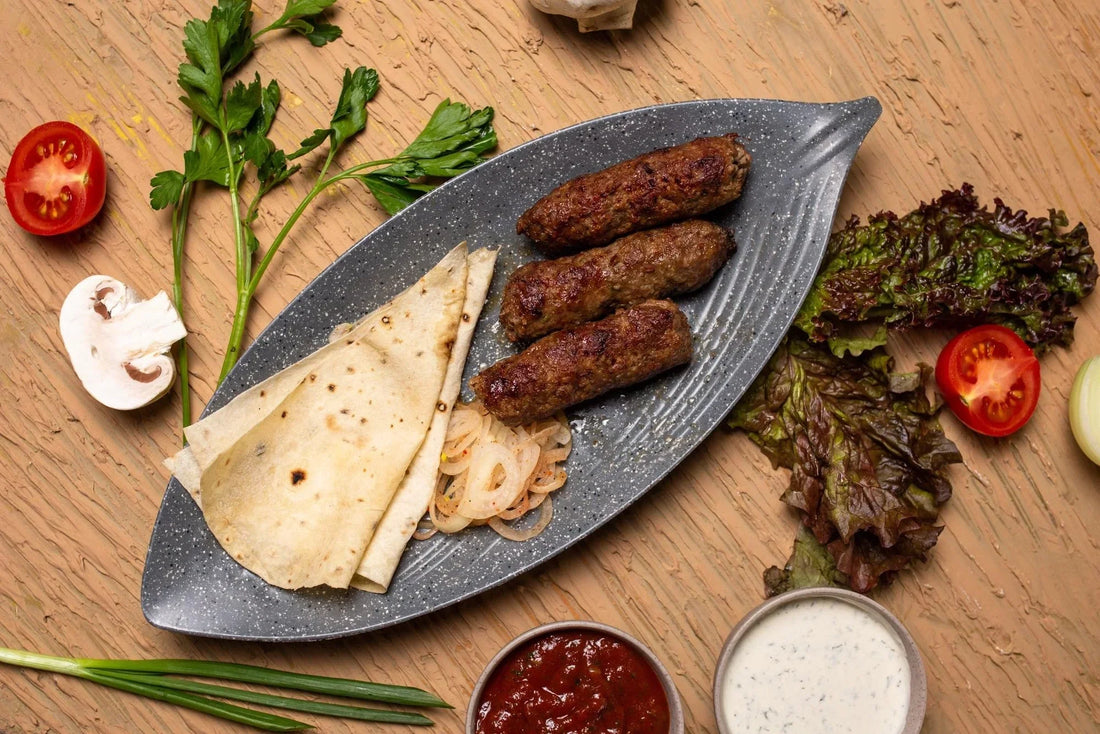
Authentic Lula Kebab recipe: Turkish flavors for your home
Teilen
The smoky aroma of grilled meat mixed with aromatic spices can transport you straight to the bustling streets of Istanbul or Ankara. Among Turkey's most beloved culinary exports, lula kebab stands out as a dish that perfectly captures the essence of Turkish cuisine. This cylindrical grilled meat delicacy has won hearts worldwide, making its way from traditional Turkish kitchens to restaurants across the globe.
What makes lula kebab particularly appealing is its accessibility for home cooking. Unlike some complex Turkish dishes that require specialized equipment, this lula kebab recipe can be mastered in any kitchen. The beauty lies in its simplicity – quality ingredients, proper technique, and patience are all you need to create restaurant-quality results at home.
What is Lula Kebab?
Lula kebab represents one of Turkey's most cherished grilling traditions. This dish consists of seasoned ground meat formed around skewers and grilled to perfection, creating a smoky, juicy delicacy that has been enjoyed for centuries. Turkish cooks developed this method to achieve even cooking while maximizing the absorption of flavor from spices and herbs.
Key Characteristics That Set Lula Kebab Apart
What distinguishes lula kebab from other kebab varieties is its unique preparation method and texture. Here are the main differences:
- Preparation Method: Unlike shish kebab with cubed meat pieces or doner kebab cooked on a vertical rotisserie, lula kebab uses finely ground meat formed into sausage-like shapes around metal skewers
- Texture Profile: Features a tender, almost creamy interior while maintaining a beautifully caramelized exterior through careful ingredient balance and specific grinding techniques
- Flavor Composition: Combines earthy spices like cumin and paprika with fresh herbs such as parsley and mint
- Aromatic Elements: Onions and garlic provide depth, while high-heat cooking creates distinctive smoky notes that define the dish
Key Ingredients for Authentic Lula Kebab

Creating authentic lula kebab starts with selecting the right ingredients. Each component plays a crucial role in achieving the traditional taste and texture that makes this dish special.
Essential Meat Selection and Preparation
The foundation of any great lula kebab recipe lies in choosing the proper meat. Here are the key requirements for authentic preparation:
- Meat Combination: Traditional recipes call for a lamb and beef mix, typically a 60-40 or 70-30 ratio
- Fat Content: Aim for approximately 20-25% fat to ensure juicy results while preventing kebabs from falling apart
- Grinding Process: Double-grinding method works best - first through coarse plate, then fine plate for smooth consistency
- Texture Goal: The final mixture should have the characteristic smoothness of authentic lula kebab spieße
Spices and Aromatics That Define the Flavor
The spice blend is what transforms simple ground meat into something extraordinary. Here are the essential seasonings:
- Cumin: Provides earthy warmth and is fundamental to the Turkish flavor profile
- Sweet paprika: Adds color and mild sweetness without overwhelming heat
- Garlic: Fresh minced garlic offers pungent depth
- Onion: Finely grated onion contributes moisture and subtle sweetness
- Fresh parsley: Chopped fine, it adds freshness and color
- Salt and black pepper: Essential for enhancing all other flavors
Binding Agents and Texture Enhancers
Traditional lula kebab recipes often include binding ingredients that help hold the meat together while adding texture and depth. Here are the most effective options:
- Fine Bulgur Wheat: Most authentic choice, providing subtle nuttiness while absorbing meat juices during cooking
- Fine Breadcrumbs: Acceptable substitute when bulgur isn't available
- Soaked Bread: Creates an incredibly tender texture when bread is soaked and squeezed before adding
- Proper Ratio: Use minimal amounts - roughly 2-3 tablespoons per pound of meat for best results
Step-by-Step Recipe for Authentic Lula Kebab
Now that you understand the components, here's how to bring them together to create a delicious homemade lula kebab.
Preparing the Perfect Meat Mixture
Start by combining your ground meat in a large mixing bowl. Add the grated onion, minced garlic, and all dry spices. Use your hands to combine ingredients, but avoid overworking the mixture. Mix until just incorporated, then cover and refrigerate for at least 2 hours. This resting period allows flavors to blend and proteins to develop, resulting in a better texture.
Shaping and Skewering Techniques
Wet your hands with cold water to prevent sticking, then take portions of the meat mixture and form them around flat metal skewers. The traditional shape is cylindrical, about 5-6 inches long, and roughly the thickness of a large sausage. Press the meat firmly onto the skewers, ensuring there are no air pockets, and refrigerate for 30 minutes to help the meat hold its shape.
Cooking Methods and Techniques
Grilling over medium-high heat produces the most authentic results. Here are the main cooking approaches and key techniques:
- Grilling: Preheat grill and lightly oil grates, cook for 12-15 minutes total, turning every 3-4 minutes
- Stovetop Method: A cast-iron grill pan works well for indoor cooking
- Oven Broiling: Place kebabs 4-5 inches from the heat source as an alternative method
- Temperature Target: Internal temperature should reach 160°F (71°C) for food safety
- Visual Cues: Exterior should develop a beautiful caramelized crust while the interior remains juicy
Let the cooked kebabs rest for 5 minutes before serving, allowing the juices to redistribute throughout the meat.
Common Mistakes to Avoid When Making Lula Kebab
Even with a good lula kebab recipe, several common errors can affect the final result. Understanding these pitfalls will help ensure success.
Mixing and Texture Problems
Overmixing is the most common mistake home cooks make. When you work the meat too aggressively, proteins break down excessively, creating a dense, rubbery texture. Mix just until ingredients are combined – the mixture should still look slightly coarse. Undermixing leaves pockets of unseasoned meat and uneven flavor distribution.
Meat Selection and Fat Ratio Issues
Here are the critical factors to consider for proper meat selection:
- Fat Content Problems: Excessively lean meat creates a dry, crumbly texture, while too much fat causes grill flare-ups
- Pre-packaged Limitations: Store-bought ground meat often lacksthe ideal fat ratio for kebabs
- Better Alternatives: Select your cuts and have them ground fresh for optimal results
- Recommended Cuts: Chuck roast combined with lamb shoulder provides excellent fat-to-meat balance
- Temperature Control: Keep the meat mixture cool during preparation to prevent fat melting
Serving Suggestions for Lula Kebab

The way you serve lula kebab can elevate the entire dining experience. Traditional accompaniments complement the rich, smoky flavors while providing textural contrast.
Classic Turkish Accompaniments
Rice pilaf stands as the quintessential traditional side dish, with its fluffy texture and subtle flavoring providing a perfect backdrop for the bold flavors of the kebab. Turkish bulgur pilaf offers a nuttier alternative that pairs equally well.
Fresh salads featuring tomatoes, cucumbers, and onions dressed with lemon juice and olive oil provide a refreshing contrast. The acidity cuts through the richness of the meat while the crisp vegetables add textural variety.
Flatbreads like pide or lavash are essential for creating wraps or simply scooping up the delicious meat. Warm the bread slightly before serving to enhance its aroma and make it more pliable.
Sauce and Condiment Pairings
Yogurt-based sauces are quintessential accompaniments. A simple mixture of plain yogurt, minced garlic, salt, and fresh herbs creates a cooling contrast to the warm spices. Cacik, the Turkish yogurt and cucumber sauce, offers similar benefits with added freshness from diced cucumber and mint.
Spicy accompaniments, such as harissa or a simple chili oil, can add heat for those who enjoy it. Turkish pickles (turşu) provide acidic brightness that cleanses the palate between bites.
Modern Presentation Ideas
While traditional presentation has its merits, modern serving styles can make lula kebab more accessible for casual dining:
- Handheld Wraps: Serve kebabs in warm pita pockets with fresh vegetables and sauce for easy, casual meals
- Family-Style Platters: Arrange kebabs ona large platter surrounded by various dips, salads, and breads
- Interactive Dining: Allow guests to create their own combinations, encouraging sharing and conversation
- Showcase Versatility: Demonstrate the adaptability of the dish through varied accompaniment options
This approach works particularly well for entertaining, as it showcases the versatility of lula kebab while creating an engaging dining experience.
Variations of Lula Kebab
Understanding regional variations and modern adaptations can help you customize this lula kebab recipe to your preferences while maintaining its authentic character.
Regional Turkish Variations
Different regions of Turkey have developed their own approaches to seasoning and preparation:
- Eastern Turkish Style: Often includes more heat from red pepper flakes for a spicier flavor profile
- Coastal Regions: Might incorporate herbs like dill or fennel for a fresher taste
- Meat Ratio Preferences: Some areas favor a higher lamb proportion, while others prefer beef-heavy mixtures
- Adana Region: Famous for spicy versions including significant amounts of red pepper paste and hot peppers
These regional differences reflect local tastes and the availability of ingredients, illustrating how traditional recipes evolve to suit different areas.
Customization Options
Personal taste preferences can guide modifications without compromising authenticity. Those who enjoy heat can increase the quantity of paprika or add cayenne pepper. For milder versions, focus on herbs like parsley and mint while reducing more pungent spices. Using all beef instead of the traditional lamb-beef combination accommodates those who avoid lamb, although the flavor profile will be different.
Modern Dietary Adaptations
Plant-based versions, such as those made with lentils, mushrooms, or commercial meat substitutes, can approximate the flavors of traditional lula kebab. These alternatives require adjustments to binding agents and seasonings. Lighter versions using turkey or chicken require careful attention to prevent drying out, as these leaner meats have less fat content than traditional recipes.
Mastering the Art of Homemade Lula Kebab
Creating authentic lula kebab at home represents more than just following a recipe – it's about understanding the balance of flavors, textures, and techniques that make this Turkish classic so special. The satisfaction of producing restaurant-quality results in your own kitchen makes the effort worthwhile, whether you're cooking for family or entertaining guests.
Don't be discouraged if your first attempt isn't perfect. Like many traditional dishes, lula kebab improves with practice. Each time you make it, you'll develop a better understanding of the meat mixture's texture, ideal cooking temperature, and perfect seasoning balance. Soon, you'll be creating memorable meals that bring authentic Turkish flavors to your dining table.

